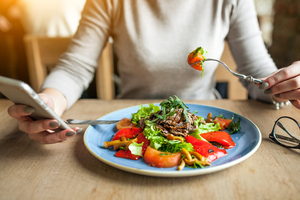In this article:
- Menus that are balanced, nutritious, and portion-controlled can help you reach your health and weight goals.
- Healthy meals are the building blocks of healthy menus. Each meal contributes calories and nutrients and impacts your mood, hunger, weight, and ability to sleep and concentrate.
- Healthy meals can be simple and family-friendly to make healthy eating more sustainable. Prep ingredients in advance, then mix and match to create multiple meals with less effort.
- Lark can help you choose more nutritious foods to reach your health and weight goals. Your Lark coach is available 24/7 to help you make healthy choices around nutrition, activity, and more.
Eating healthy for the long haul may be easier than you think. It’s possible to make balanced meals that are simple and tasty. You can save time and energy by preparing ingredients and dishes in advance. In addition, you can stay on your meal plan and satisfy your family’s demands with minor modifications.
What’s a Balanced Meal?
A balanced meal helps you get to your health goals. There are different approaches to making a balanced meal.
You can use macronutrient goals to help build balanced meals. For example, the Acceptable Macronutrient Distribution Range (AMDR) is the range that’s linked to long-term health and weight management. Using AMDR:
- Carbohydrates are 45-65% of total calories
- Protein is 10-35% of total calories
- Fat is 20-35% of total calories
- Keep saturated fat under 10% of total calories
In addition, you and your healthcare provider can set individual macronutrient goals for your personal needs, like a low-carb or high-protein diet.
Another approach to building healthy meals is to use food groups. In each meal, try getting at least one serving from 3-5 food groups. Here are some groups to consider.
- Non-starchy vegetables like lettuce and other greens, cucumbers, carrots, tomatoes, broccoli, peppers, and onions
- Lean proteins like fish, egg whites, beans, lentils, skinless chicken, peanut butter, and reduced-fat dairy like low-fat cheese, cottage cheese, and plain nonfat yogurt
- Fruit including fresh fruit and unsweetened frozen fruit
- High-fiber starchy foods like whole grains and starchy vegetables like peas, corn, potatoes, and sweet potatoes
- Healthy fats like avocado, olive oil, canola oil, peanut butter, nuts, and seeds
Another approach is to use the Plate Method to help build balanced meals. It helps with portion control and balance. Here’s how to use the Plate Method.
- Fill half your plate with a non-starchy vegetable
- Fill one-quarter of your plate with a lean protein
- Fill one-quarter of your plate with a high-fiber carbohydrate
Then, add healthy fats, fruit, and/or reduced-fat dairy products to some meals to complete your balanced plate using the plate method.
Simple Meals for Sustainable Healthy Eating
Making simple meals can save time and energy, which can make healthy eating more sustainable over the long term.
Here are some tips for keeping meals simple.
- Try sandwiches, salads, bowls, and sheet pan meals
- Mix and match ingredients to make a variety of meals like soups, stews, casseroles, and salads with only a few ingredients
- Cook in batches to have leftovers and reduce preparation time
- Make one meal for the family by serving additional components if family members want them. Examples include sauces, toppings like croutons and bacon bits, and potatoes
Steps to Making Simple Meals
Try these four steps to making a balanced meal.
- Prep and use or store ingredients or dishes ahead of time. Wash, peel, chop, and cook vegetables; cook grains; prepare and cook beans, chicken, fish, and other proteins; make healthy dressings and dips and freeze them in ice cube trays.
- Mix and match. When it’s time to prep meals, gather ingredients. Repeat them as much as possible. For example, if you’re repeating cooked vegetables, whole-grain pasta, beans, and chicken, here are some meals you could make.
- Minestrone soup: Vegetables plus whole-grain pasta plus beans
- Pasta dinner: Vegetables plus whole-grain pasta plus marinara sauce plus cooked chicken
- Pasta salad: Vegetables plus whole-grain pasta plus cooked chicken, feta cheese, dried oregano, olive oil, and vinegar
- Bean bowl: Vegetables plus beans plus shredded cheese plus corn or brown rice
- Taco salad: Greens plus other vegetables plus beans plus salsa plus corn plus chicken
- Craft proper portions. Check labels or use the plate method to approximate serving sizes. You can also measure using a measuring cup and spoons or by “eyeballing” it.
Here are serving sizes of some common foods.
- Lettuce and other salad greens: 1+ cups (softball)
- Vegetables, yogurt, cut fruit: 1 cup (baseball)
- Fish, tuna: 3 ounces (checkbook)
- Chicken, turkey burger: 3 ounces (deck of cards)
- Cooked beans, cooked whole-grain pasta, brown rice: ½ cup (tennis ball)
- Hummus, peanut butter, salad dressing: 1 ounce (two tablespoons) (golf ball)
- Cheese: 1 ounce (tip of thumb
- Please every eater! If you’re cooking for family members, identify simple ways you can modify the meal you’re cooking in order to please everyone. Examples might include serving yourself plain broccoli before adding cheese sauce to it for the other diners, or serving whole-grain pasta plain so you can add marinara to your own and others can add meat sauce. Or, take a smaller portion of what you’re serving to others if it’s not on your own meal plan; for example, take less steak and potatoes, and add a large green salad with vinaigrette to your own dinner.











.webp)







